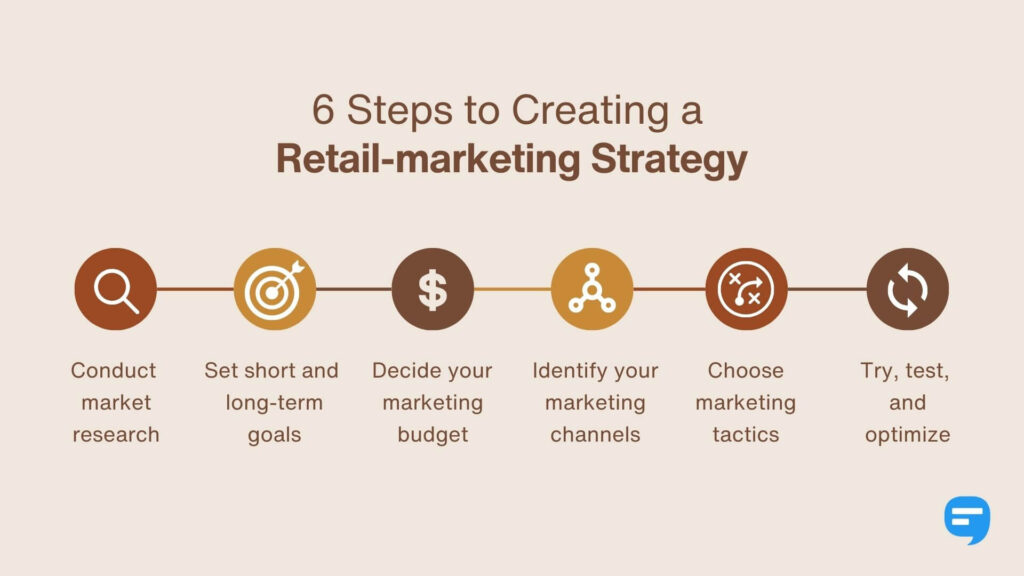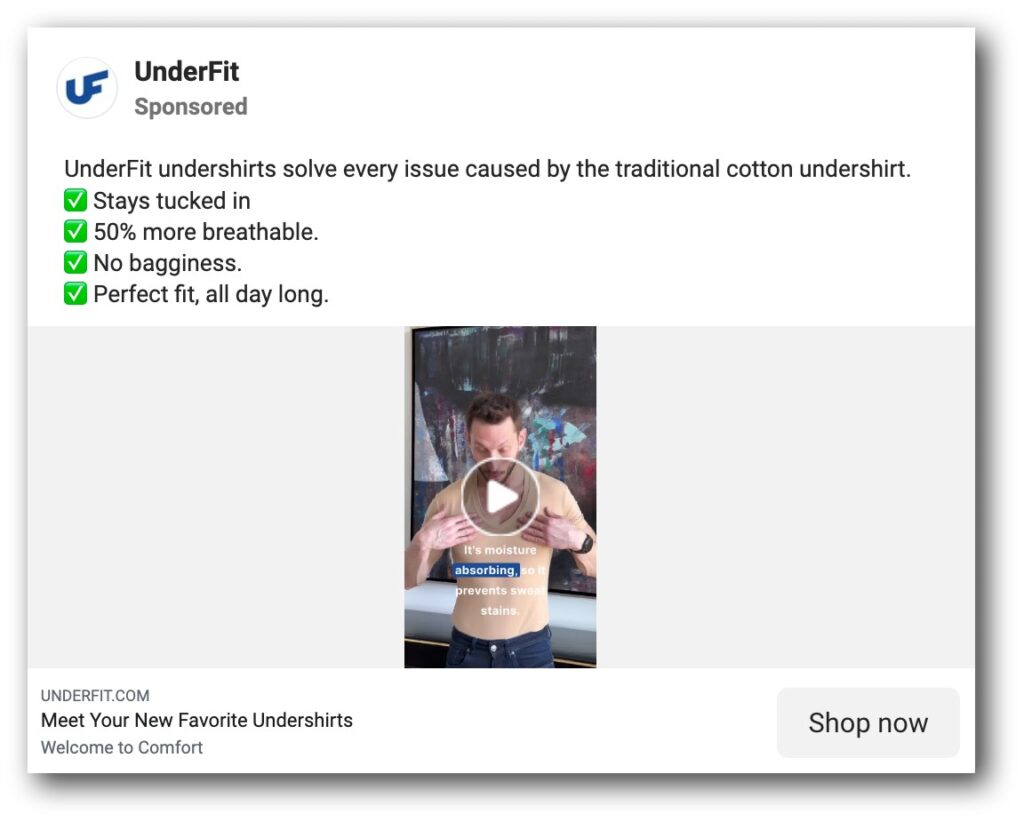How to Build a Results-Driven Retail Marketing Strategy
Learn how to build a results-driven retail marketing strategy that leads to more sales, better brand awareness, and higher customer loyalty.

Learn how to build a results-driven retail marketing strategy that leads to more sales, better brand awareness, and higher customer loyalty.

After chatting with over a dozen retail store owners, it’s clear that running a retail store is no easy feat. It’s a juggling act, as you have to deal with a lot of responsibilities simultaneously. Even now, you may be juggling between managing inventory, dealing with suppliers, and handling customer complaints at the same time.
And let’s not forget how hard it is to acquire new customers, retain existing ones, and increase your sales in today’s ever-competitive market. It’s even harder if you don’t have a results-driven retail marketing strategy in place.
Below, I’ll share the exact steps you need to follow to build a solid retail marketing strategy, based on my research and conversations with retailers like UnderFit, Busy Baby Mat, and Eu Natural.
I’m excited to share my insights with you. So, without further ado, let’s dive straight into it.
Here are the exact steps you need to follow to create a results-driven retail marketing strategy:

By the end of this post, you’ll have a clear understanding of how to adapt each of these steps to your business.
The most successful businesses are the ones that understand their market way better than anyone else. Conducting market research is the first and most important step in building your retail marketing strategy.
Running marketing campaigns without understanding your market is like driving a car with a blindfold on.
Let’s say you run a retail business that sells luxury fashion clothing and accessories. In this case, your target audience is likely to be higher-income individuals who value luxury and quality.
If you don’t conduct market research, you won’t have a clear understanding of their preferences, challenges, and behaviors.
What’s worse, you may end up targeting the wrong people. What if you craft marketing campaigns that also target low-income individuals who can’t afford your luxury products?
But that’s just one part.
Conducting market research involves:
Let’s touch down on each of them one by one.
The first part of market research is understanding your industry. This involves analyzing the current state, including market size, key trends, growth rate, and any potential opportunities and challenges. At the same time, it’s equally important to understand how your industry has evolved in the last few years and what the future holds.
Doing this will help you understand the overall landscape, allowing you to identify areas where your retail business can excel.
Alongside this, it’s equally important to study economic factors that influence the industry, including consumer spending patterns, inflation, interest rates, and supply and demand.
Also, make sure you understand the legal and regulatory requirements that are specific to your industry or the products you sell (like cannabis, cosmetics, alcohol, and healthcare). After all, the last thing you want is to fall into legal trouble while trying to market your brand.
Some other areas you should focus on while conducting industry research are social and cultural factors, political factors, and environmental and sustainability concerns.
By no means am I asking you to become an expert in every area mentioned in this section. However, it’s important to at least have a basic understanding to make strategic decisions and avoid pitfalls.
The golden rule of marketing is that you should know everything there is about the people you want to sell to. After all, the last thing you want to do is drain your marketing budget targeting the wrong people.
Let’s revisit the same example I mentioned above.
Suppose you run a retail business that sells luxury fashion and clothing accessories. Your target audience is likely higher-income individuals who value luxury and quality. But that’s not enough.
You need to dig deeper.
Start by understanding what their needs, preferences, and challenges are. If you don’t conduct audience research, you won’t be able to craft brand messaging that resonates with them.
If you want to sell to them, you need to understand:
I can’t tell you how much I love conducting competitive analysis.
That’s because it doesn’t just provide you with information about your competitors but also helps you gain insights into your audience’s behavior and preferences.
By conducting a thorough competitive analysis, you will be able to:
Learning from your competitors’ failures will help you save time, effort, and money that you’d have otherwise spent on the wrong channels and tactics. At the same time, you can take their success stories as inspiration while building marketing campaigns.
You’ve probably heard this popular saying from Abraham Lincoln, “Give me six hours to chop down a tree and I will spend the first four sharpening the axe.”
Market research, just like sharpening the axe, is just the first step in the process. Sure, it can take a long time, but it makes the rest of the process easier.
Once you have concluded your market research, the next step is to start cutting down the tree by setting short and long-term marketing goals, which will help you ensure that you’re heading in the right direction.
Short-term goals are goals that you’d like to achieve within a relatively short period, like in the next quarter or a year.
Long-term goals are goals that you’d like to achieve in the next few years. Setting long-term goals helps you keep the bigger picture in view.
So, let’s say you have recently launched your retail store. In this case, a few good long-term (five-year) goals can be:
To achieve these long-term goals, you need to plan and set strategic short-term goals. For example, to hit $10M in annual revenue in five years, a few of my short-term (one-year) marketing goals would be:
You can further break down these short-term goals into actionable and measurable objectives.
Setting short-term goals helps you incrementally progress towards your long-term plans. Setting long-term goals helps you paint the bigger picture.
Last but not least, make sure you’re consistently measuring the progress of your goals. This will help you understand whether your marketing strategies are delivering the desired results or not. Keep an eye on key performance indicators (KPIs) like customer acquisition cost, conversion rate, website traffic email list growth.
The KPIs you should be tracking will vary depending on what your goals are, what channels you’re targeting, and the strategies you’ve implemented.
When I began my career in marketing, I read a lot of articles claiming, “SEO is free.” However, my extensive seven years of experience in the marketing industry tells a completely different story.
I’m sorry to break it to you, but SEO is not free.
Sure, you can get started for free, but you’ll eventually have to spend your money hiring experts, purchasing tools, and investing in other resources to implement an effective SEO strategy.
Similarly, whether you’re planning to invest in email marketing or social media marketing, you’ll have to spend money on:
The point is that marketing your brand is not cheap. And it surely isn’t free.
You need to spend money on the right channels and tactics to achieve your goals. Because of this, it’s important to set aside a dedicated marketing budget.
A general rule of thumb is to invest around seven to eight percent of your total revenue for marketing. However, this percentage can vary depending on your goals, industry, competition, and more.
Tip – Considering you have a limited budget and resources, focus on no more than one or two channels at once. You can scale up and increase your marketing budget as your marketing efforts deliver fruitful results.
Conducting market research can help you understand where your audience hangs out the most and which channels your competitors are focusing on. But that doesn’t mean you should focus on all the channels your competitors are targeting.
Whether you should focus on a specific channel or not heavily depends on your goals and marketing budget. If your competitor is spending $10,000 on Google ads yet your marketing budget is just $1,000 a month, it may not be feasible for you to compete with them in that channel.
Using the information you collected in the steps above, prepare a list of marketing channels that makes sense to focus on.
Here are a few marketing channels (narrow down your list based on your research) you may want to focus on:
And more!
Once you have prepared a list of marketing channels, the next step is to list down the tactics that you can implement to promote your retail business through these channels.
For example, if your chosen marketing channel is Instagram, then a list of tactics might include:
Similarly, for all channels you’ve shortlisted, you need to determine the specific tactics that will help you reach your target audience and achieve your marketing goals.
To help you stand out in today’s competitive market, I’ve compiled a list of effective marketing tactics that have delivered retail businesses some serious results:
Tap into user-generated content (UGC)
Customers don’t want to see another one of those overly produced videos from retail brands. Instead, they want to see marketing content that they can relate to. You’ll have a much better chance of converting a potential customer by putting in front of them a video testimonial from one of your existing customers versus a video advertisement.

Leigh McKenzie, the founder of UnderFit is a big-time believer in using UGC content. He stated, “We’re leveraging UGC content a lot for our ads growth. It’s a cheap yet effective way to iterate on advertising ideas, and prospective customers seem to resonate with them way more. I once spent $10k on a higher quality studio shoot (including photos) and they provided less value than the content our customers create. Also, getting your product in the hands of real people (even if they are paid) is a great way to learn what works.”
Implement shoppable videos on your online store
Customers are growing tired of the same old traditional online shopping experience. They don’t really want to make their purchasing decisions solely based on a couple of product images, a product description, and text-based customer reviews. They crave an experience that allows them to experience the products they’re about to purchase in a real-world setting prior to purchasing them.
With shoppable videos, retail businesses can do just that. Online retail store Busy Baby Mat, an online retail store, increased their conversion rate by a staggering 11.49% after implementing shoppable videos on their website using Videowise, an e-commerce video platform.
Run SMS marketing campaigns
So many businesses overlook SMS as a marketing channel. By using SMS marketing to promote your business, interact with your customers, deliver regular updates, and offer exclusive deals, you can increase customer engagement and drive sales.
Eu Natural, one of Amazon’s top supplement brands, generated a staggering 563% ROI with just one SMS campaign powered by SimpleTexting. One of the reasons why SMS marketing has a better ROI than other marketing channels is that SMS messages have an incredibly high open rate of 45%, on average. And it’s a great way to quickly interact with your customers.
A few other powerful retail marketing tactics include:
You should continuously measure the results of your marketing campaigns — it’s the only way you can identify what’s working for your retail business and what’s not. After all, what works for one business may not necessarily work for another.
In the initial stages, you may not have a gigantic marketing budget to invest thousands of dollars in one specific channel or tactic. But at the same time, you may also want to test out different channels and tactics to find out which ones deliver the best results.
In that case, it’s a good practice to allocate small chunks of your marketing budget to different channels and tactics and measure results after a set time period. Doing this will help you understand what’s worth investing in without spending too much money upfront.
Measuring the results of your retail marketing campaigns will help you not only understand what’s working what’s not. It’ll also further optimize these campaigns for better results, helping you generate more sales.
Also, it’s important to note that trying, testing, and optimizing should be treated as an ongoing process. A few platforms you can use to test and measure your marketing results (heavily depends on the channel you’re focusing on) include Google Analytics, Kissmetrics, Hotjar, Gigasheet, and Supermetrics.
Whether you have recently launched your e-commerce store or have been in the game for years, trying, testing, and optimizing your marketing campaigns consistently will help you ensure that your retail marketing efforts are delivering the best possible results.
That’s how you can build a solid retail marketing strategy. Think of this guide as a starting point. Depending on your industry, business model, and several other factors, you may need to customize the steps to suit your specific needs.
To help you further, I’ve put together a few valuable resources that can assist you in growing your retail business:
Check out how Pallas Seeds uses texting to inform and empower its community of growers
ReadLearn what makes a successful in-store message display as well as how text-enabling your ad can be the key to driving more sales.
ReadStart a text marketing campaign or have a 1-on-1 conversation today. It's risk free. Sign up for a free 14-day trial today to see SimpleTexting in action.
No credit card required